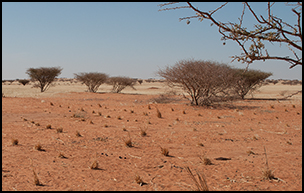Crossref Citations
This article has been cited by the following publications. This list is generated based on data provided by
Crossref.
Brass, Mike
2019.
Beyond the Nile: new archaeological research in Sudan and South Sudan.
Azania: Archaeological Research in Africa,
Vol. 54,
Issue. 4,
p.
421.
Rosenzweig, Melissa S.
2020.
Confronting the Present: Archaeology in 2019.
American Anthropologist,
Vol. 122,
Issue. 2,
p.
284.
Barron, Aleese
Fuller, Dorian Q.
Stevens, Chris
Champion, Louis
Winchell, Frank
and
Denham, Tim
2020.
Snapshots in time: MicroCT scanning of pottery sherds determines early domestication of sorghum (Sorghum bicolor) in East Africa.
Journal of Archaeological Science,
Vol. 123,
Issue. ,
p.
105259.
Biagetti, Stefano
Ruiz-Giralt, Abel
Madella, Marco
Khalid Magzoub, Mongeda
Meresa, Yamane
Gebreselassie, Mulubrhan Haile
Veesar, Ghulam Mohiuddin
Abro, Tasleem Alam
Chandio, Amin
and
Lancelotti, Carla
2021.
No Rain, No Grain? Ethnoarchaeology of Sorghum and Millet Cultivation in Dryland Environments of Sudan, Pakistan, and Ethiopia.
Ethnoarchaeology,
Vol. 13,
Issue. 1-2,
p.
80.
Zerboni, Andrea
Brandolini, Filippo
Mariani, Guido S.
Perego, Alessandro
Salvatori, Sandro
Usai, Donatella
Pelfini, Manuela
and
Williams, Martin A.J.
2021.
The Khartoum-Omdurman conurbation: a growing megacity at the confluence of the Blue and White Nile Rivers.
Journal of Maps,
Vol. 17,
Issue. 4,
p.
227.
Lancelotti, Carla
and
Biagetti, Stefano
2021.
Mapping Food Production in Hyper-Arid and Arid Saharan Africa in the Holocene—A View from the Present.
Quaternary,
Vol. 4,
Issue. 2,
p.
13.
Ryan, Philippa
Kordofani, Maha
Saad, Mohamed
Hassan, Mohammed
Dalton, Matthew
Cartwright, Caroline
and
Spencer, Neal
2022.
Nubian Agricultural Practices, Crops and Foods: Changes in Living Memory on Ernetta Island, Northern Sudan.
Economic Botany,
Vol. 76,
Issue. 3,
p.
250.
D’Agostini, Francesca
Vadez, Vincent
Kholova, Jana
Ruiz-Pérez, Javier
Madella, Marco
and
Lancelotti, Carla
2022.
Understanding the Relationship between Water Availability and Biosilica Accumulation in Selected C4 Crop Leaves: An Experimental Approach.
Plants,
Vol. 11,
Issue. 8,
p.
1019.
Lancelotti, Carla
and
Madella, Marco
2023.
Handbook of Archaeological Sciences.
p.
701.
Nixon-Darcus, Laurie A.
and
D’Andrea, A. Catherine
2023.
Traditional Knowledge and Ethnoarchaeological Investigations in the Northern Ethiopian Highlands: Pathways to Understanding Past and Present Foodways.
Ethnoarchaeology,
Vol. 15,
Issue. 2,
p.
180.
Forti, Luca
Costanzo, Stefano
Compostella, Chiara
Garna, Giancarlo
Morandi Bonacossi, Daniele
and
Zerboni, Andrea
2023.
The geoarchaeological investigation on the defunctionalisation of an Assyrian canals system reveals Late-Holocene land use transitions in Northern Mesopotamia.
The Holocene,
Vol. 33,
Issue. 4,
p.
416.
Rieger, Anna-Katharina
2023.
Water as a Problem and a Solution in Arid Landscapes: Resilient Practices and Adapted Land Use in the Eastern Marmarica (NW-Egypt) between the 2nd Millennium BCE and the 1st Millennium CE.
Land,
Vol. 12,
Issue. 5,
p.
1109.
Ruiz-Giralt, Abel
Beldados, Alemseged
Biagetti, Stefano
D’Agostini, Francesca
D’Andrea, A. Catherine
Meresa, Yemane
and
Lancelotti, Carla
2023.
Sorghum and Finger Millet Cultivation during the Aksumite Period: Insights from Ethnoarchaeological Modelling and Microbotanical Analysis.
Journal of Computer Applications in Archaeology,
Vol. 6,
Issue. 1,
p.
96.
Regattieri, Eleonora
Forti, Luca
Drysdale, Russell N.
Mannella, Giorgio
Hellstrom, John C.
Conati Barbaro, Cecilia
Bonacossi, Daniele Morandi
and
Zerboni, Andrea
2023.
Neolithic hydroclimatic change and water resources exploitation in the Fertile Crescent.
Scientific Reports,
Vol. 13,
Issue. 1,
Ruiz-Giralt, Abel
Biagetti, Stefano
Madella, Marco
Lancelotti, Carla
and
Farooq, Shahid
2023.
Small-scale farming in drylands: New models for resilient practices of millet and sorghum cultivation.
PLOS ONE,
Vol. 18,
Issue. 2,
p.
e0268120.
D'Agostini, F.
Ruiz-Pérez, J.
Madella, M.
Vadez, V.
Kholova, J.
and
Lancelotti, C.
2023.
Phytoliths as indicators of plant water availability: The case of millets cultivation in the Indus Valley civilization.
Review of Palaeobotany and Palynology,
Vol. 309,
Issue. ,
p.
104783.
Stevenson, C. M.
Naranjo-Cigala, A.
Ladefoged, T. N.
and
Díaz, F. J.
2023.
Colonial rainfed farming strategies in an extremely arid insular environment: Niche construction on Lanzarote, Canary Islands, Spain.
The Journal of Island and Coastal Archaeology,
Vol. 18,
Issue. 2,
p.
196.
Gallegos-Poch, Fernanda
Viguier, Benoît
Menanno, Giovanni
Mandakovic, Valentina
Yáñez, Gonzalo
Gutiérrez, Sergio
Lizarde, Catalina
Vargas Araya, Jaime
López-Contreras, Camila
Mendez-Quiros, Pablo
Maldonado, Antonio
and
Uribe, Mauricio
2023.
Integration of Near-Surface Complementary Geophysical Techniques for the Study of Ancient Archaeological Areas in the Atacama Desert (Pampa Iluga, Northern Chile).
Surveys in Geophysics,
Vol. 44,
Issue. 2,
p.
495.





